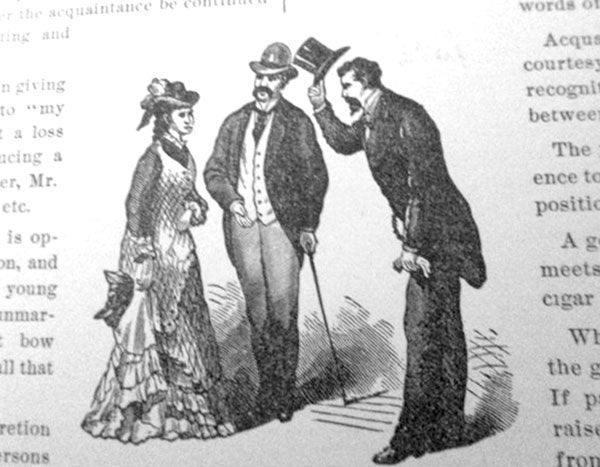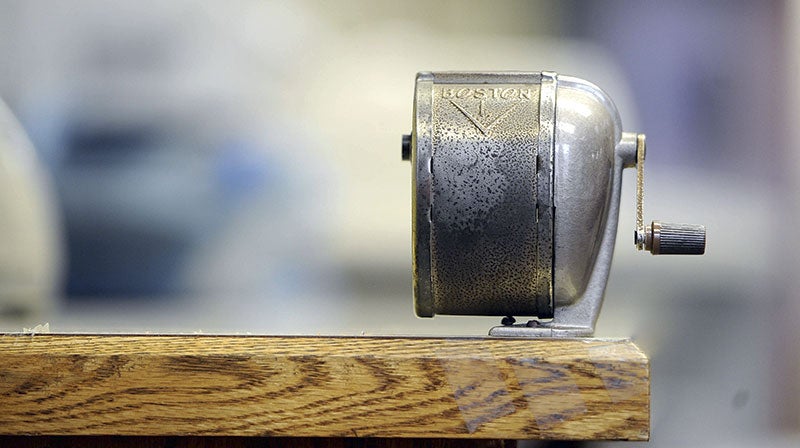Full Circle: Sometimes a romance novel trumps the wisdom of ‘The New Book of Etiquette’
Published 10:14 am Friday, October 16, 2015
Last weekend as I riffled through a box of old yellowed classics at the Austin Library used book sale, I discovered a small leather-bound volume that appeared to hold the promise of wisdom. Not just any old wisdom, mind you, but great wisdom! Knowing I could use some, I opened to the first chapter. Boy, was I right! Wisdom oozed out of its dry crinkly pages like mustard out of a hotdog bun. I couldn’t buy it fast enough.
Back home, I nestled into my recliner, angled my reading lamp over my left shoulder, laid a polar fleece wrap across my legs, snuggled my dog up beside me and readied myself for an education.
Copyright: 1924. Hmmmm … so, the book was ninety-one years old! But, did that matter? Well, no, it didn’t. After all, in the core of my being I knew there still dwelled within me an old fashioned girl.
“The New Book of Etiquette,” revised edition with illustrations!
Chapter One: Morals
“There is no outward sign of courtesy that does not rest on a deep moral foundation.” Goethe.
Wow! That was certainly deep, alright. But, moral, I wasn’t so sure. For did I really need to be morally deep in order to say to a friend, “Whassup, Bro?” As it turned out the book said I did.
Furthermore I also I found out that yelling “Hey, Bubba, whachadoin’?” across Main Street was boorishly ill-mannered. Still, wasn’t I just being convivial? But, then, maybe it would have been a whole lot better if I had said, “Hey, Mister Bubba, whachadoin’?”
The worst thing was, I wasn’t exactly sure if it was the “Bubba” part, the “whachadoin’” part or leaving out the “Mister” part that broke all the rules of etiquette? Even though they all sounded morally right to me, it appeared my greeting was in bad taste for right there on page ten it was as clear as a Fredericks of Hollywood nightgown: “Yelling across the street is not ladylike!” Sheesh! My good manners definitely needed to be gooder! Morally gooder!
Chapter Two: Public Behavior
As I turned to this chapter, I would be less than honest if I didn’t tell you that Chapter One had left me feeling decidedly scorned. I mean, what girl wanted to be recognized as a clod — especially in public? And would the town fathers expose my base public behavior in an editorial in the Herald? I could see the headline now: “Local Senior Turns Churlish!”
But, by then the hardest part was the realization that the town fathers were right. I was vulgar! And reading further didn’t help one iota … “There are countless trifling tests of good manners that distinguish the well-bred from the dolts.” That was me, alright, the dolt.
Chapter Three: Public Meetings
“Two young women meeting in public should greet each other simultaneously. When one of the women is married and the other is unmarried and they are meeting for the first time after an introduction, a bow of recognition should come from the former.” Whew! That was sure complicated. I guess what the book was trying to say was that a simple “Pleased ta meet cha,” wouldn’t do. But wait! Maybe that rule didn’t apply if let’s say I was divorced or if we were not meeting simultaneously or if it wasn’t for the first time or if I had forgotten to bow. I’d have to check on this.
By now my feelings of discomfort were markedly distressing. It was as if the author was right there talking directly to me. For reassurance, I pulled my polar fleece blanket even tighter around my legs. Then I flipped the page.
Chapter Four: Hats
“When a man meets a woman in the street, he removes his hat and does not put it back on until they go their respective ways. If such an occurrence happens on a very frigid Minnesota day, he may ask permission from the lady to replace his hat.” What? You gotta be kidding! Does this mean that in order to be proper, this frozen feckless fellow must wait until his nose cracks off?
But, hold on, there was more: “The truly well-mannered woman may herself graciously suggest that he replace his hat.” Gimme a break! It you ask me, what she should suggest is, “Hey, you dunderhead, put that beaver pelt back on before you freeze your rear off!” … even if it was at the risk of sounding gauche.
All this wisdom got me thinking. What if this same scene took place in July? The book said, “In fair weather, the tall silk hat or the derby should be lifted up by holding the brim directly in the front and raising it high enough to escape messing up the man’s hair. This is best accomplished by moving the hat forward a few inches from the head as he doffs.” You don’t say?
But I can tell you this! There was nary a trace of any mention of removing a backward baseball cap. I’m thinking that was purposely omitted. Anybody knows that a formfitting cap like that has smashed the man’s pompadour tightly to his gentlemanly head, making him appear, when he does remove it, to be wearing a hairy skull cap that faintly resembles a former but presently smashed pompadour. In this situation, I’m venturing a bet that it is best that he not remove it for I would imagine that such a sight could cause embarrassment to even the most moral of squires. You know the ones — the squires wearing backward baseball hats!
By now I was squirming in my recliner as if chiggers had gotten into my pants. Did this etiquette stuff really — I mean really and truly! — apply to me? Sure, I wanted to be a lady just like the next girl, but come on! Making some poor polite fellow keep his beaver pelt off in January until his nose cracked off seemed a bit harsh. Good grief! Not really my idea of good manners.
Chapter Four: Introductions to a King or Queen
Gimme a break! Did I really need this? But, hold on! I just might! For who knew when I might run into the Mayor of Austin? Additionally there was the off chance that I could meet Princess Kay of the Milky Way — when, that is, she wasn‘t posing in her refrigerated chambers while having her countenance carved with a butter knife by a Land ‘O Lakes sculptor. Yes, for sure, I’d better memorize this chapter. By now I was so overwhelmed, I couldn’t imagine what to expect next.
Chapter Five: Incorrect Forms of Introduction
“The phrase, ‘Let me make you acquainted with’ should be stricken from one’s vocabulary for it is awkward, unpolished and more than anything shows a lack of social distinction. It is equally as rude to use the phrase — ‘I want you to meet my friend’ because you imply the other person is not your friend.”
Touchy, touchy. For crying out loud, this book was beginning to sound as thin skinned as The Donald! I decided to skip it.
Chapter Six: Letter Writing
“In some instances it is acceptable to typewrite a letter. Anything as modern and convenient as the typewriter should certainly have a place in social life.” Well, I’ll be darned! And I’ll bet she wears a laced-up corset, too! “Still, the paper must be slightly smaller than commercial size — 8 by 10 inches as opposed to 81/2 by 11 inches.” Spare me. I could picture the clerk at Shopko measuring the pages.
By now I was flat out weary of this book’s wisdom. Did it or did it not apply to me and, if so, did I really and truly want to be this stilted? Deciding that I didn’t, I left the house with the used book tucked under my arm. I was getting a refund! By the time I walked into the used book sale, I had decided a better fit for me might be found in the heavy breathing, bodice ripping dictates of a romance writer.
“Hey, you, Mister Bubba,” I yelled across the room, “where’re yer Harlequins?”
Peggy Keener of Austin is the author of “Potato In A Rice Bowl,” which outlines her experiences living in Japan in the 1960s while her husband was in the military. Peggy Keener invites readers to share their memories with her by emailing pggyknr@yahoo.com. Memories shared with Keener may be shared or referenced in subsequent editions of “Full Circle.”



